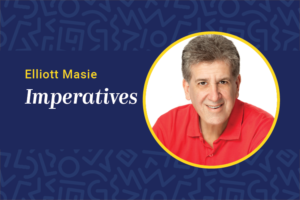
‘New’ is often inaccurate as a learning descriptor — and potentially damaging.
by Elliott Masie
February 24, 2016
I am so tired of the word “new.”
Let’s say a leadership development program develops a graphic with a new model for how management should work. The facilitator tells people they are seeing a “new and radical” shift in focus.
The graphic on the slide looks so familiar to participants. One of them searches on the corporate intranet and finds almost the same graphic, with slightly different box titles, used to describe new leadership programs announced in 1997, 2003, 2009 and 2012. Sigh.
My inbox fills with emails from learning suppliers every week, declaring brand new products and services. They are often described as being the “leading approach in the world” and also “brand new” in the same sentence. But most of the product announcements are evolutions, stretches and refinements of existing models.
The word “new” can be so overused and toxic that many email filtering programs will send any note with it in the subject line directly to the spam bucket. Learners often have the same biological reaction to a declaration that something is brand new, as they immediately scan their brains to find deeply similar and familiar ideas.
To be honest, learners are often insulted and disengaged by the promiscuous use of “new.” Sure, the marketing and communication folks love using “new” in the hope it will get viral coverage and distribution. Teachers and learning designers also love using “new” in the hope that managers and learners will gravitate to programs that promise to be radically different.
Yet, “new” backfires almost all of the time. Creativity is not about being new. It is about stretching our current realities to consider alternative elements, pathways, technologies or models of things that are current.
Learning is especially sensitive to “new.” The moment an instructor or program announces that something is new, they are assuming — or even discounting — the relevancy of everything the learner already knows.
When I was teaching my 80-year-old mother about email 20 years ago, I described it as a small change for how she could communicate with her grandchildren. She even jumped ahead and asked if the note was “sealed” or if anyone could open it. Her knowledge about mail allowed her to rapidly understand and start using email because it felt familiar.
I asked a well-known management author how much he uses participants’ current knowledge of a seminar when introducing his new approach to leadership. Truthfully, he said, he wanted the participants to forget what they knew about leadership and embrace his new paradigm. Sigh.
What if the participants were asked to frame up their current and familiar models of leadership instead? Then, they could build from that knowledge base to construct his approach. I would be delighted if someone told me they could tweak my current model and show observable gains. That is more believable than any pitch about totally re-engineering our approach to leadership.
Malcolm Knowles, the godfather of adult learning, said one of the key differences about adults is that we bring decades of knowledge, experience and intuition to the learning experience. Announcing something is new often asks the learner to act more like an inexperienced child. He would delight in knowing that most new knowledge already exists in some ways within adult learners.
In this age of continuous innovation and creativity, it is easy to feel excited about new. I dream aboutreally new models for learning apps, connected classrooms, brain-function monitoring, machine learning, video mentoring and dynamic, adaptive assessment.
But achieving those dreams will probably involve honoring all that is old and working, and creatively looking at elements or processes that are different, that involve stretching or that are counterintuitive. Many of them will be new, but why shout that word at that start of all our announcements?
Invite learners to try something and experience what is better, which is usually a combination of old, new and random. If it is truly new to learners, let them discover and define that for themselves.




